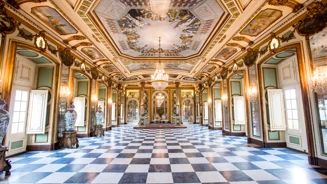The museological remodelling of the Robillion Pavilion at the National Palace of Queluz has begun
28 Jan 2025
Based on conclusions drawn from the study of inventories and other documentation from the late 18th and early 19th centuries, Parques de Sintra has begun to reformulate the exhibition discourse of the Robillion Pavilion at the National Palace of Queluz, which will cover a total of nine rooms and take place in phases. The main aim of the project is to provide visitors with better contextualisation and interpretation of the space, which successively housed the quarters of Pedro III and Maria I; João VI, as regent and king; and, for shorter periods, Miguel I and Pedro IV.
The implementation of this project will lead to changes in the names of various rooms, which will return to their original designations, allowing for a better understanding of their functions. With the passage of time, this memory has been lost, but will now be recovered. At the same time, some items from the collection will be relocated while others will return to their original locations.
Initially, the most significant changes will be in the Dispatch Room, which will be renamed the Waiting Room, where those who were received by the king waited. As a result, the cabinet-desk that stood in this room will move to the space hitherto identified as Carlota Joaquina's Room, but which in reality was the Dispatch Room of João VI and Miguel. We now know that this area of the Palace was never occupied by Carlota Joaquina. In fact, her personal quarters were on an upper floor (no longer extant) and, in the last years of her life, in the spaces between the Throne Room and the Hunting Room, whose museography will be revised in the future to evoke the queen's presence and experiences.
The the Ladies in Waiting Room will also be renamed to its original title: the Crockery Room. An analysis of inventories from the time revealed that various tea and dinner sets of oriental (China) and European (Meissen, Germany) origin were kept there, some of which were used in the neighbouring Dining Room, now known as the Picnic Room.
The Ambassadors' Room will once again be called the Porcelain Room. The Chinese porcelain pots (which used to be called “talhas”) lend their name to this room, which was used by João VI, as Prince Regent, for audiences with diplomats and, previously, for musical events.
Other major changes will take place from the second half of the year, namely in the Don Quixote Room, the adjoining antechamber and the oratory in these rooms. The Don Quixote Room will be remodelled and will display a reconstruction of Don Pedro IV's bed, based on existing iconography. The oratory will also be reconstructed on the basis of descriptions in historical inventories and the only known old photograph of it, dated 1905. Several paintings that were placed there for King João VI will return to this small room, such as Our Lady of the Conception, painted in Brazil by J.B. Debret, who accompanied the king on his return to Portugal in 1821.
Finally, the Dressing Room will also undergo some changes to reflect its functions over time. Designed as a dressing room for Pedro III and Maria I, it later served as a bedroom for João VI and Miguel I.
The reformulation of the Robillion Pavilion's exhibition discourse is expected to be ongoing until late 2025 or early 2026.

